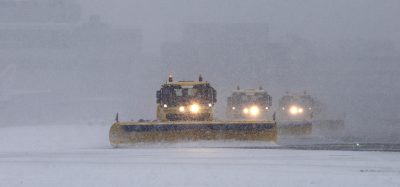More than just Scotch mist
- Like
- Digg
- Del
- Tumblr
- VKontakte
- Buffer
- Love This
- Odnoklassniki
- Meneame
- Blogger
- Amazon
- Yahoo Mail
- Gmail
- AOL
- Newsvine
- HackerNews
- Evernote
- MySpace
- Mail.ru
- Viadeo
- Line
- Comments
- Yummly
- SMS
- Viber
- Telegram
- Subscribe
- Skype
- Facebook Messenger
- Kakao
- LiveJournal
- Yammer
- Edgar
- Fintel
- Mix
- Instapaper
- Copy Link
Posted: 7 December 2012 | Mark Stuart, Director of Operations at Highlands and Islands Airports Ltd | No comments yet
In the last few years the UK has experienced winter weather conditions more akin to the Arctic, with sub-zero temperatures and extremes of weather that have tested the transport system to its limits. With Scotland often bearing the brunt, regional airport operator HIAL has developed innovative ways to keep passengers flying, even in the harshest conditions.
Highlands and Islands Airports Ltd (HIAL), a publicly owned airport operator accountable to Scottish Ministers, is responsible for the safe and efficient operation of 11 regional airports across Scotland. In 2011/12, the group handled 1.26 million passengers, an increase of 8.7 per cent on the previous year. The busiest airport in the group, Inverness, handled more than 607,000 passengers, an increase of 12.8 per cent.
In addition to operating Inverness Airport, the gateway to one of Scotland’s fastest growing cities, HIAL is also responsible for ensuring that lifeline links are maintained through the operation of airports in remote locations across the Scottish Highlands and Islands; from Campbeltown in Argyll to Wick John O’Groats, the most northerly airport on the UK mainland, and the island airports of Stornoway, Benbecula, Kirkwall and Sumburgh, as well as the world famous beach landing strip at Barra in the Western Isles. HIAL also operates Dundee Airport at Scotland’s fourth largest city.
In the last few years the UK has experienced winter weather conditions more akin to the Arctic, with sub-zero temperatures and extremes of weather that have tested the transport system to its limits. With Scotland often bearing the brunt, regional airport operator HIAL has developed innovative ways to keep passengers flying, even in the harshest conditions.
Highlands and Islands Airports Ltd (HIAL), a publicly owned airport operator accountable to Scottish Ministers, is responsible for the safe and efficient operation of 11 regional airports across Scotland. In 2011/12, the group handled 1.26 million passengers, an increase of 8.7 per cent on the previous year. The busiest airport in the group, Inverness, handled more than 607,000 passengers, an increase of 12.8 per cent.
In addition to operating Inverness Airport, the gateway to one of Scotland’s fastest growing cities, HIAL is also responsible for ensuring that lifeline links are maintained through the operation of airports in remote locations across the Scottish Highlands and Islands; from Campbeltown in Argyll to Wick John O’Groats, the most northerly airport on the UK mainland, and the island airports of Stornoway, Benbecula, Kirkwall and Sumburgh, as well as the world famous beach landing strip at Barra in the Western Isles. HIAL also operates Dundee Airport at Scotland’s fourth largest city.
Scotland’s winter climate can be extreme, and the breadth and variety of locations and microclimates that HIAL experiences test the practical and logistical abilities of the highly skilled winter operations teams. Given this wide variety of extreme conditions, staff at HIAL are as well trained and equipped to deal with snowy and icy conditions as any airport operator in Europe.
The winters of 2009/10 and 2010/11 saw some of the harshest and prolonged winter weather conditions experienced in the UK for decades and conditions tested our airports to their limits. But they also afforded us the opportunity to learn and to further hone the skills required to keep the lifeline links to remote Scottish communities open.
Preparation
The backbone of winter operations at HIAL is the airport fire service which is responsible for co-ordinating and carrying out snow clearing at each airport. Following the severe winter of 2009/10 HIAL undertook a ‘root and branch’ review of winter operations across the group.
The first action was to visit a location well suited to dealing with extreme winter conditions; Norway. HIAL contacted Norwegian state owned airport operator Avinor – which operates 46 airports across the country – and arranged a benchmarking visit to better understand the types of winter equipment used, and the training regime and operating procedures in place. HIAL’s Chief Engineer and Chief Fire Officer visited three airports, including Category 4, 5 and 9 operations, and discovered that although there were a number of similarities in the equipment types, there were some differences in how the equipment was used and setup across the group. In addition, our Avinor hosts also stressed the importance of training for all operational crews from equipment drivers to snow clearing co-ordinators. Whilst operational staff within HIAL were experienced in winter operations, a specific formal winter operations training and assessment programme was not in place at that time.
Training
Armed with the knowledge acquired in Norway, the HIAL winter operations group set clear objectives in order to achieve success. The key objectives were to provide personnel with the appropriate level of technical knowledge in effective snow clearing in order to provide competence based training to snow clearance co-ordinators, and to improve overall airport capability to deal with the effects of winter weather, whether that be de-icing, snow clearing or a combination of both. Work streams were established to include driver training, de-icing product technical knowledge, snow-clearing co-ordinators training and competence, communications and planning. Taking into consideration the multi-site operations, the training modules were presented centrally to airport snow clearing co-ordinators who then took the modules back to their airports and initiated staff training. This training was completed by early November 2010 in preparation for winter 2010/11 and is now an annual requirement of the winter operations programme.
Snow plans and communication
Each of our airports has detailed snow plans which document how the snow and ice clearing is to be achieved including the tasks and responsibilities of each department on the airport. These plans outline clear lines of communication, equipment availability and operating procedures. The plans are reviewed prior to, and during, the winter period to monitor their effectiveness. Winter resilience is now a key political area and HIAL has a winter comm – unications plan to provide guidance for keeping civil servants, Ministers and the public updated with the latest information on airport openings or possible delays. The head office operations department consolidates the information regarding the impact of the weather on operations at all the airports and updates the Scottish Government several times a day during periods of disruption. The advent of 24 hour news and social media requires that information is timely and, more importantly, accurate. The head office operations department also acts as the logistical co-ordinator during severe weather to support the airports with de-icing fluid deliveries, winter operations equipment and any other support they may require.
Equipment
As a result of the recent poor winters, a review of winter operations equipment identified that the basic equipment at some of the smaller airports was not fit for purpose. Furthermore, the larger airports also required equipment upgrades to enhance overall reliability.
As a result, HIAL purchased six SB90 refurbished brush blowers, six articulated units to pull the SB90, six ploughs, five Claas 140bhp tractors fitted with ploughs or snow buckets and five small Kubota tractors fitted with 1,200mm ploughs and 1000 litre de-icer sprayer units. We have an SB90 stored and maintained at Inverness Airport on standby, which can be deployed day or night to anywhere in the group.
The HIAL engineers have also designed and built bespoke equipment for the airports to reflect local conditions, including a runway de-icer trailer designed and built by the MT Engineers at the Inverness workshops. The trailer is a backup for the main Foden 10,000l de-icer tanker, and holds 5,000 litres of runway de-icer, has a 15 metre wide spray boom, a self-contained pump system and can be pulled by a tractor or an aircraft tug.
The equipment review highlighted that snow ploughs would work more efficiently if polyurethane blades were used, rather than the old style hard rubber blocks, as these would increase the road speed of the snow clearing vehicles and therefore open our runways quicker than with the old style blades. Once again these modifications were carried out in-house.
Airfield de-icing fluid
A key issue experienced during the winter of 2009/10 was de-icing fluid supply. Suppliers struggled to meet demand and – because of the extreme weather conditions – experienced problems with logistics and communications. At HIAL, a team from the operations department worked continuously over a six week period with our de-icer supplier to co-ordinate transport arrangements, including the ordering and delivery of de-icing fluid to the most badly affected airports. Building on the lessons of 2009/10, the winter operations group has forged relationships with a number of de-icing suppliers to increase resilience into the de-icer supply chain and ensure business continuity. This has been achieved by trialling a number of approved runway de-icing products to ensure they can deliver the performance required for the climatic conditions experienced in the Highlands and Islands. This process has mitigated the risk of failure to supply by one provider. We have also trialled and utilised solid de-icing pellets, applied in conjunction with liquid de-icer, in order to mitigate the build-up of ice leading to rutted patches on our runways; this technique has proved effective when dealing with rutted areas, particularly in the Western Isles where the problem was persistent.
We also now hold contingency de-icer stocks at Inverness Airport, with plans to roll out further contingency stock to Campbeltown Airport, which is readily available for immediate transport to any of our airports. This will help to mitigate the risk of supplier delivery issues to remote locations by road as a result of the winter conditions. We have also invested in a de-icing farm at Inverness Airport containing 165,000 litres of fluid, and our main runway de-icing supplier holds 200,000 litres of contingency stock for HIAL in the North of Scotland to mitigate production and demand issues.
The airfield de-icer training we have developed with our main supplier has paid huge dividends, with operational staff retaining vital knowledge on the science behind the efficiency of de-icing fluid. The training includes the preparation of the runway surface by removing as much moisture as possible to reduce the effects of dilution, and measuring the concentration levels on the ground using a refractometer to determine the freezing point of the fluid, which is critical to the successful application of de-icing fluid. Guesswork has been removed from the decision making process, and fluid is only applied when necessary once the freeze point of the fluid has been established and cross referenced to the forecast temperature. As a result, costs have reduced and the purchased stock lasts longer, building resilience into the operation.
HIAL is currently participating in a CAA winter trials programme aimed at accurately reporting contaminated runway surface conditions. This trial is being conducted in conjunction with airlines, airport operators and the CAA in an effort to improve the subjective runway reporting process to allow aircraft to operate safely by developing an enhanced assessment format using phraseology to describe estimated braking action. This is obtained by assessing the runway state against a reference table using type of contaminant and depth.
For winter 2011/12, HIAL will also be utilising the Open Runway forecasting tool provided by the UK Met Office in order to more accurately predict the conditions at those airports that have been most severely affected by snow and ice in recent years: Inverness, Stornoway (Outer Hebrides), Wick John O’Groats, Kirkwall (Orkney) and Sumburgh (Shetland). The more accurate forecasting will improve the effective – ness of de-icing operations, reduce wastage with regard to fluid application, target the provision of snow watches during nonoperational hours, mitigate environmental risks associated with fluid application and reduce the overall cost of winter operations.
Operating in winter conditions
To describe a typical day during winter operations as variable would be an understatement (the year round advice for visitors to Scotland is to come prepared for four seasons). The challenges can vary from blue skies and ice/frost to freezing rain and hail and drifting snow. Additionally, conditions often change very quickly, which tests our operational resilience and preparedness. The challenge for HIAL is to ensure that runways are kept open to maintain the flow of aircraft movements – even in adverse weather con – ditions, passengers expect runways to be open, within reason – and that airport staff, our passengers, airlines and third parties are able to go about their business safely. Given the lifeline nature of many of the air services provided by HIAL airports, it is even more important that we do everything we can to keep any disruption to a minimum.
In order to achieve this, it is fundamentally important that operational staff are well trained and competent to fulfil their part of the pro – cedures. Snow clearance co-ordinators undertake annual training and assessment prior to winter to ensure their knowledge and skill levels are maintained to the highest standard. Equipment drivers also carry out familiarisation on equipment so that when winter strikes, all equipment is used to maximum effect with minimum delay. The engineering department also ensure that all equipment is serviced prior to winter and engineers are on standby 24 hours a day to deal with any breakdowns that may occur.
The winter operations review and improve – ments to our in-house training programme has undoubtedly helped our airports manage in extremely challenging conditions. What sets Scotland and the UK apart from some of our European neighbours, particularly those in Scandinavia, is the variety of conditions from day to day and year to year.
Scotland, and the Highlands and Islands are a fantastic place to live, work and visit, with some stunning scenery in remote locations. The challenge for HIAL is to maintain air connectivity during winter in order to maintain the lifeline links, enable the economic development of the region and facilitate air transport for residents and visitors alike. In order to do this HIAL will continue to seek innovative ways to improve its readiness to deal with such adverse and changeable conditions, to keep staff motivated and trained and to maintain equipment in preparation for whatever the Scottish winter has in store for us.
About the author
Mark Stuart has been with HIAL since January 2011. Following a 10 year career in the UK Armed Forces, the former Cavalry Officer moved into financial services before completing an MBA at the University of Edinburgh Business School and joining Menzies Aviation, running ground handling operations across Scotland. He joined Highlands and Islands Airports as Director of Operations following a period with airport operations IT systems specialist Amor Group, based in Glasgow.

















